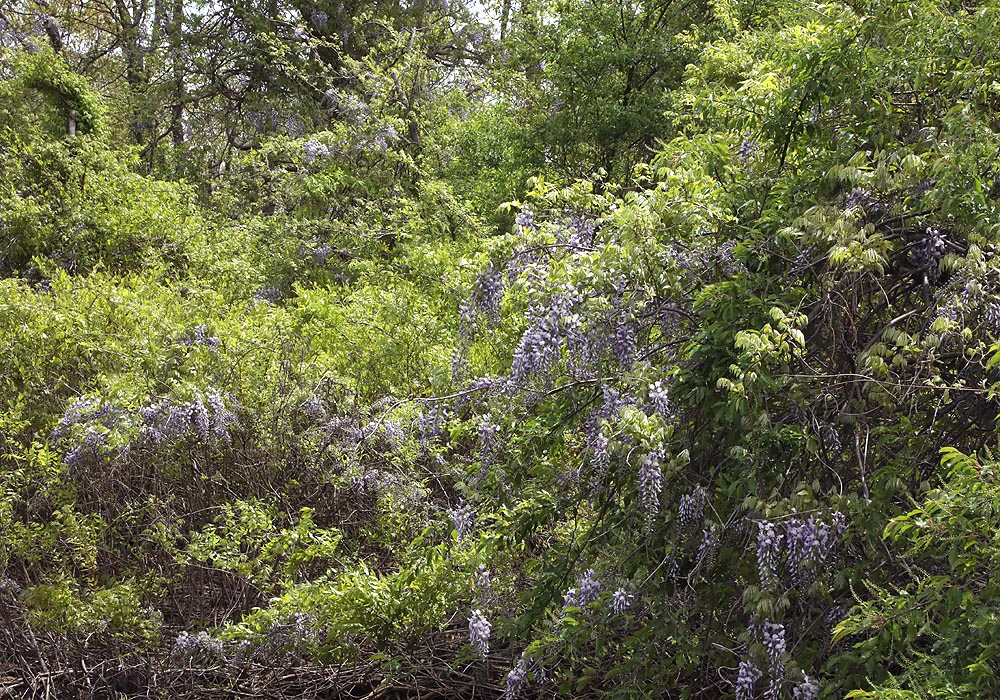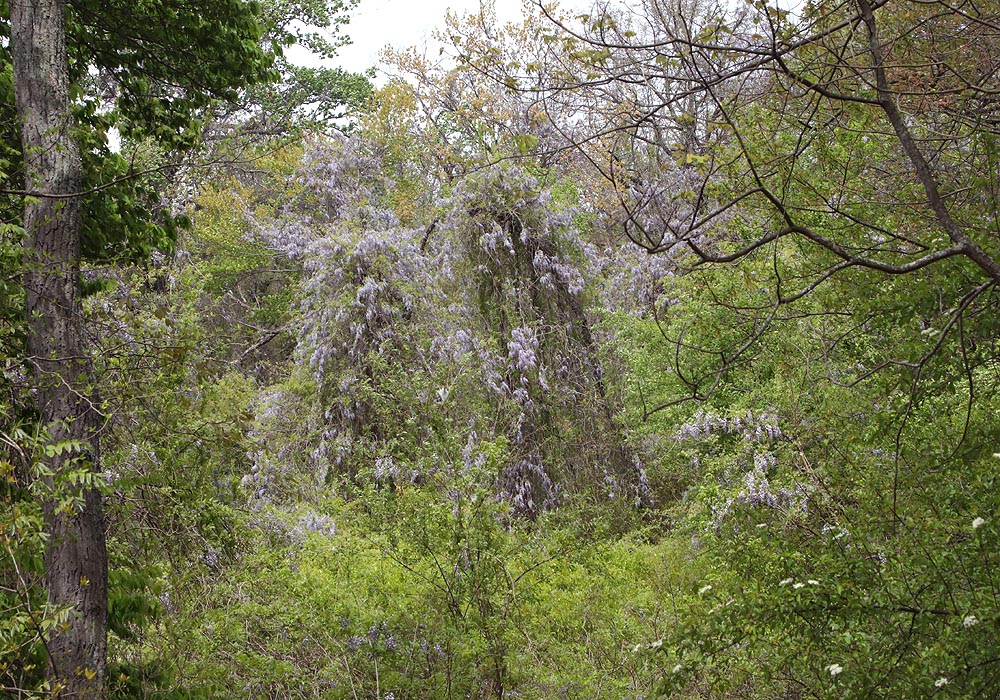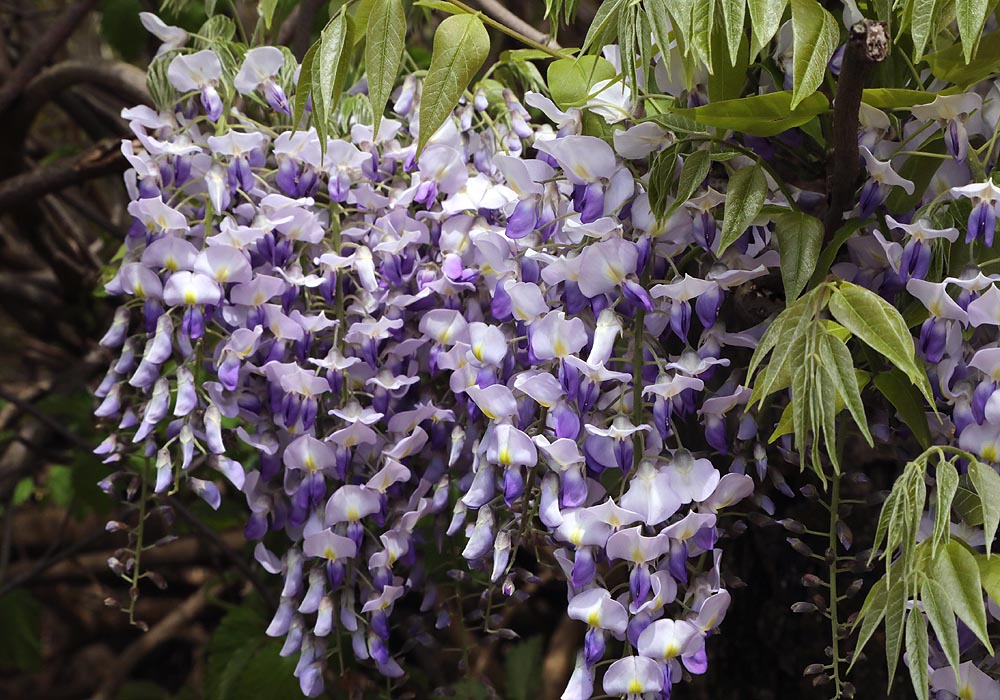Wisteria Can Be Invasive. Keep It Under Control

The definition of an invasive plant is one that takes over an area and spreads blocking out all other plants and basically creating a monoculture. Not all invasives are non native and not all are spread by seeds scattering. Wisteria is one of these. If tended it can be kept well under control but if left alone it can destroy a habitat spreading mostly by suckers.
Here it's shown just how destructive wisteria can be if left alone.
Wisteria has taken over the whole river bank for almost a mile
The area is a state park about 45 minutes from our farm in central New Jersey. Its situated on the bank of a tidal river. There is an old house there, from the limited information available it appears to be the remains of an old plantation house known in historical documents as 'Breezy Ridge House'. It was originally built around 1780 and was added to and changed over the years. The walls and roof are solidly built from concrete, brick and stone and its a shame the park service has not repaired it and turned it into a historic site or at least a nature center. Now its just covered in graffiti. There is no wisteria near the house so most likely it was planted next to a barn our outbuilding when the place was a 500 acre plantation. It was used to grow fruit trees grains and raise cattle. The plantation passed down through the generations getting smaller each time until a lot of the land was sold to a mining company to extract sand and gravel and its unclear just how close this operation came to the house There is a large flat mostly open area behind the house which could easily have been used for growing crops or grazing animals. The view over the creek is very pleasant and at that time would have been full of wild birds and fish.
The State acquired most of the land during the 1960's and turned it into a
state park but it has been largely left alone with little development and not
much in the way of maintenance. Who planted the wisteria vine somewhere along
the river we will never be known but certainly somewhere before 1960 when the
State took over the land and the few remaining residence moved on.
Sadly when this happened no one went in and removed the 'garden' plants the
plantation owners had planted. While a few yucca bushes and some lily of the
valley that pops up every spring is a pleasant surprise on a hike the wisteria
is devastating.

Wisteria has completed covered all the original vegetation in this image. A lot of the trees are already dead, the others will be soon.
As you can see from the photos and video it has taken over a HUGE portion of the river bank, almost a mile. Wisteria likes sunshine so it gravitated to the shoreline and up the trees. It will climb any tree to the top if it can. To do so it spreads by suckers along the ground until it finds something else to climb up then its off again and moving further along the shore. As it moved it smothers the trees and kills them. many fall to the ground so it moves further back into the forest which now has more sunlight and climbs another tree.
The ground is covered in short wisteria fronds all producing new suckers and
looking for somewhere to climb. Left unchecked as this one has it will eventually
take over the whole river bank, kill the host trees and move further and further
back into the forest. Nothing can stop it but a massive cull with a aggressive
removal of all the suckers that have grown up. It is doubtful that this will
happen with this one since it spreads nearly a mile along the river bank and
between 600 and 1000 feet into the forest depending on location.

With the exception of the tall trees on the top left of this image. ALL the vegeation you can see is Wisteria. It has completely take over the floor of what was once the forest.
The only good news is that wisteria seeds don't seem to germinate well. This bush produces masses of seeds every year but there are no small offshoots of the plant in other parts of the park. True there is one other set but that seems to be associated with an additional home that was also abandoned, that one has yet to spread as far, most likely because it has less direct sunshine than the first house.

While its not easy to see just how much the wisteria has taken over the tall trees in the background the ones in the center are completely covered and all the lower vegetation in the foreground is wisteria suckers.
While there are several open sunny spots in the woodland where the vines could have taken root that have not, so its likely that the seeds don't germinate well. This is good for the forest if not the whole thing would now be covered in just wisteria vines and the homes surrounding the park with be inundated with small seedlings. Thank goodness this has not happened.
There is no doubt that wisteria is a beautiful plant with lovely flowers and divine aroma but if you have one make sure that you keep it under control and never, never let it climb your trees especially if they are close to your home. It may look nice but it will smother and kill the tree. Dead trees tend to fall and falling on your home would not be a good thing.
Keep wisteria suckers under control remove them as they arise and never let it get out of control. Wisteria grows very quickly and can advance across your garden in a single season if you are distracted and don't watch it carefully. Keep it cut back, pull and dig out any suckers that are moving across the ground and popping up elsewhere and never let it into a tree.
If by slim chance your house is abandoned or you sell to become a park or open space. Please dig out and destroy your wisteria before you leave. Don't let it take over the land.

On a sad note. We spent several hours checking out this wisteria infestation,
taking photos and evaluating the spread of the plant. In that time we saw only
TWO BEES! All those flowers and NO BEES!
Help save the bees we need them. Grow pollinator plants and create places for
pollinators to nest and overwinter. No bees, no food.
| Janice Hazeldine PhD is the owner and head grower of Floral Encounters an organic Medicinal Herb farm that is also a designated sanctuary for pollinators. |





